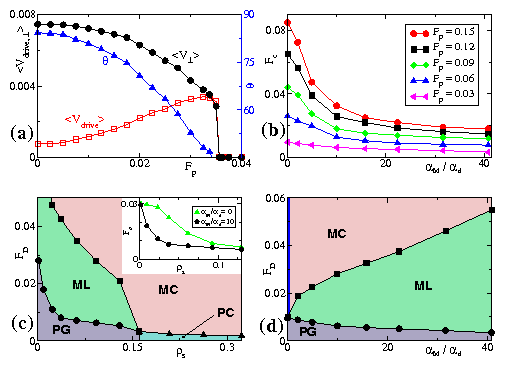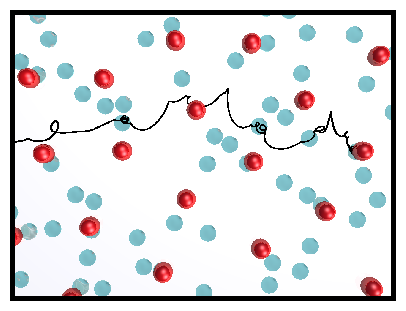 Figure 4:
(a) 〈Vdrive〉, 〈V⊥〉, and θ
vs Fp
at
FD = 0.0075.
(b) Critical depinning force Fc vs αm/αd
for Fp = 0.15, 0.12, 0.09, 0.06, and 0.03 (top to bottom).
(c) Phase diagram for FD vs ρs
at
Fp = 0.03,
highlighting the transitions from PG to ML (circles),
ML to MC (squares), and
PC to MC (triangles).
Inset: Depinning threshold (PG-ML transition line)
for Magnus-dominated (circles)
and damping-dominated (triangles) systems.
(d) Phase diagram of FD vs αm/αd for
Fp = 0.03,
showing transitions from PG to ML (circles) and
ML to MC (squares).
Overdamped particles with αm/αd=0 form a moving
smectic state (heavy line).
Figure 4:
(a) 〈Vdrive〉, 〈V⊥〉, and θ
vs Fp
at
FD = 0.0075.
(b) Critical depinning force Fc vs αm/αd
for Fp = 0.15, 0.12, 0.09, 0.06, and 0.03 (top to bottom).
(c) Phase diagram for FD vs ρs
at
Fp = 0.03,
highlighting the transitions from PG to ML (circles),
ML to MC (squares), and
PC to MC (triangles).
Inset: Depinning threshold (PG-ML transition line)
for Magnus-dominated (circles)
and damping-dominated (triangles) systems.
(d) Phase diagram of FD vs αm/αd for
Fp = 0.03,
showing transitions from PG to ML (circles) and
ML to MC (squares).
Overdamped particles with αm/αd=0 form a moving
smectic state (heavy line).
|
